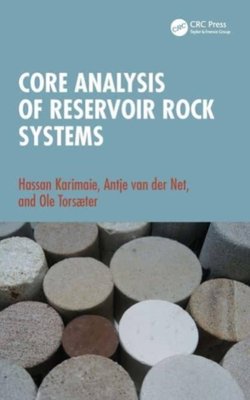
Book description
Core analysis is an essential source of quantitative data on reservoir properties. These data are used for modeling the distribution and flow of oil and gas reservoirs, CO2 and hydrogen storage, and flow behavior in geothermal reservoirs. While several books cover core analysis for practitioners, this book fills a gap through introducing laboratory equipment and procedures used in core analysis and the theoretical aspects of the parameters. It offers detailed instructions on experimental execution for those with limited or no experience including risk analysis for high safety.
- Emphasizes the basic characterization of porous materials for multiphase flow, specifically consolidated natural materials.
- Features methods commonly used in the special core analysis within the oil and gas industry, extending to the emerging field of gas storage with occasional references to research-oriented equipment.
- Offers detailed descriptions of laboratory exercises and instructions on data analysis suitable for student work.
- Includes solutions to some exercises to demonstrate the application of measured parameters in reservoir evaluation.
- Provides a unique combination of brief discussions on the basic theory of parameters, explanations of experimental principles, detailed experimental procedures according laboratory standards, and data analysis, with multiple laboratory-related example problems.
This concise and practical workbook is written for everyone interested in practical measurements of parameters needed for analysis of fluid flow in porous media, specifically students, or for starting staff in the laboratory preferably with a background in geosciences or fluid mechanics, or related topics.
Table of Contents:
Front Matter. 1. Introduction. 2. Working in the laboratory. 3. Core preparation and fluid saturation. 4. Fluid properties. 5. Porosity. 6. Electrical properties of porous media. 7. Absolute permeability. 8. Surface and interfacial tension. 9. Wettability. 10. Capillary pressure. 11. Relative permeability. 12. 2D and 3D flow visualization.
- Publisher : CRC Press
- Publication date ebook : 29 November 2024
- Edition: 1st edition
- Language : English
- Hardcover : 396 pages
- ebook ISBN: 9781003382584
- ISBN : 9781032466187
- Item Weight : 1.59 pounds
- Dimensions : 234 * 156 mm
- Purchase: Core Analysis of Reservoir Rock Systems | ARK Bokhandel
- Purchase: Core Analysis of Reservoir Rock Systems | Hassan Karimaie, Antje van d (taylorfrancis.com)
About the authors:
Hassan Karimaie is instructor of RE course/Senior Reservoir Engineer at Three60Energy/Petroleum Chair and associate professor at KNUST.

Antje van der Net is Associate Professor at the department of Geoscience, NTNU, Trondheim, Norway, and associated member of PoreLab

Ole Torsæter is Professor Emeritus in reservoir engineering at the department of Geoscience at NTNU and associated member of PoreLab

